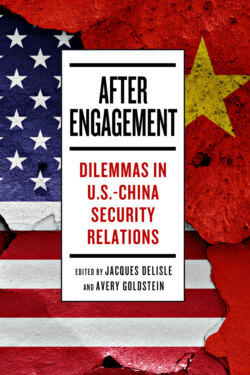Читать книгу After Engagement - Группа авторов - Страница 9
На сайте Литреса книга снята с продажи.
An Adversarial Relationship Emerges
ОглавлениеBy the end of Obama’s presidency, and near the close of Xi’s first term as general secretary of the Chinese Communist Party (CCP) and president of the PRC, it was clear the next US administration would have to manage a more contentious relationship with a more competitive China. When Donald Trump took office in 2017, the downturn in US-China relations accelerated sharply, and the two sides moved rapidly toward addressing each other as adversaries or prospective adversaries. A negative assessment of China—and a turn to more unaccommodating policies—increased during Trump’s first years in office amid mounting frustrations with Chinese policies and behavior.
The Trump administration’s National Security Strategy and its National Defense Strategy explicitly identified China (listed along with, but before, Russia) as a revisionist power posing a serious threat to US interests. Both documents included unprecedented language that forewent the more mixed assessments of bilateral relations found in such documents during previous administrations. For example, according to the National Defense Strategy summary:
China is leveraging military modernization, influence operations, and predatory economics to coerce neighboring countries to reorder the Indo-Pacific region to their [sic] advantage. As China continues its economic and military ascendance, asserting power through an all-of-nation long-term strategy, it will continue to pursue a military modernization program that seeks Indo-Pacific regional hegemony in the near-term and displacement of the United States to achieve global preeminence in the future.27
When Xi Jinping delivered major addresses in October 2017 and March 2018 boldly proclaiming the CCP’s determination to realize the country’s rejuvenation and make it one of the world’s leading military and economic powers by the middle of the twenty-first century, he was declaring a timeline for ending the era of American primacy that had followed the Cold War.28 As US-China rivalry deepened, economic disputes sharpened with the onset of a disruptive “trade war” in 2018.29 Although negotiations made some progress by late 2019 with the announcement of a “Phase 1” trade deal, the outbreak of, and response to, the COVID-19 pandemic in 2020 led to escalating mutual recriminations that accelerated the deterioration in US-China relations. To some observers, these fast-unfolding events confirmed their belief that the two countries were entering a new era, reprising the dangers of the Cold War that had defined Soviet-American relations for much of the second half of the twentieth century.30
The timing of the change, and the intensity and swiftness of the downturn in US-China relations, serve as a reminder that unexpected events (as had occurred with the 9/11 terrorist attacks) and personalities of leaders (in this case, Xi Jinping and Donald Trump) affect the nature and timing of outcomes.31 Nonetheless, the transformation of US-China relations during the 2010s resulted from more fundamental causes operating at the international and national levels that made the shift from limited competition to more comprehensive rivalry likely, if not inevitable.
